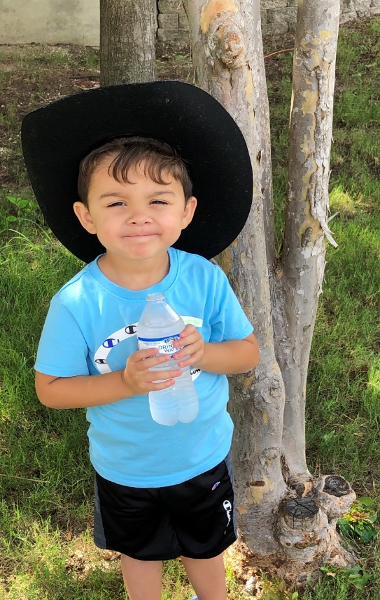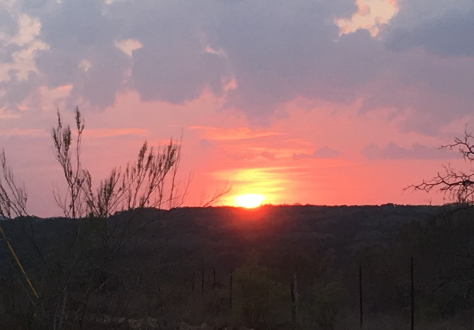Summer’s Sizzling Heat
Happy Summer, San Marcos! The early dawns and late dusks make for long days to enjoy the beautiful natural areas which we are lucky to have here in San Marcos. But along with our everlasting summer days comes the extreme heat. Before venturing out on your hikes in the Greenbelt, make sure you are prepared to deal with the sizzling heat. Failure to do so can lead to serious medical conditions:
HEAT EXHAUSTION and HEAT STROKES
From chart, note what to do if you are experiencing these symptoms.
From the Mayo Clinic:
CAUSE: Your body’s failure to cool itself
In hot weather, your body cools itself mainly by sweating. The evaporation of your sweat regulates your body temperature. However, when you exercise strenuously or otherwise overexert in hot, humid weather—like that in San Marcos—your body is less able to cool itself efficiently.
As a result, your body may develop heat cramps, the mildest form of heat-related illness. Signs and symptoms of heat cramps usually include heavy sweating, fatigue, thirst, and muscle cramps. Prompt treatment usually prevents heat cramps from progressing to heat exhaustion.
You usually can treat heat cramps by drinking fluids or sports drinks containing electrolytes and getting into cooler temperatures, such as an air-conditioned or shaded place, and resting.
Risk Factors
Anyone can develop heat exhaustion, but certain factors increase your sensitivity to heat. They include:
- Young age or old age. Infants and children younger than 4 and adults older than 65 are at higher risk of heat exhaustion. The body’s ability to regulate its temperature isn’t fully developed in the young and may be reduced by illness, medications, or other factors in older adults.
- Certain drugs. Medications that affect your body’s ability to stay hydrated and respond appropriately to heat include some used to treat high blood pressure and heart problems (beta blockers, diuretics), reduce allergy symptoms (antihistamines), calm you (tranquilizers), or reduce psychiatric symptoms such as delusions (antipsychotics).
- Obesity. Carrying excess weight can affect your body’s ability to regulate its temperature and cause your body to retain more heat.
- Sudden temperature changes. If you’re not used to the heat, you’re more susceptible to heat-related illnesses, such as heat exhaustion, because your body hasn’t had a chance to get used to the higher temperatures.
- A high heat index. The heat index is a single temperature value that considers how both the outdoor temperature and humidity make you feel. When the humidity is high, as is often the case in San Marcos your sweat can’t evaporate as easily and your body has more difficulty cooling itself, making you prone to heat exhaustion and heatstroke. When the heat index is 91 F (33 C) or higher, you should take precautions to keep cool.
Untreated, heat exhaustion can lead to heatstroke, a life-threatening condition that occurs when your core body temperature reaches 104 F (40 C) or higher. Heatstroke requires immediate medical attention to prevent permanent damage to your brain and other vital organs that can result in death.
Prevention
 You can take a number of precautions to prevent heat exhaustion and other heat-related illnesses. When temperatures climb, remember to:
You can take a number of precautions to prevent heat exhaustion and other heat-related illnesses. When temperatures climb, remember to:
- Wear loose fitting, lightweight clothing. Wearing excess clothing or clothing that fits tightly won’t allow your body to cool properly.
- Protect against sunburn. Sunburn affects your body’s ability to cool itself, so protect yourself outdoors with a wide-brimmed hat and sunglasses and use a broad-spectrum sunscreen with an SPF of at least 15. Apply sunscreen generously and reapply every two hours — or more often if you’re swimming or sweating.
- Drink plenty of fluids. Staying hydrated will help your body sweat and maintain a normal body temperature.
- Take extra precautions with certain medications. Be on the lookout for heat-related problems if you take medications that can affect your body’s ability to stay hydrated and dissipate heat.
- Never leave anyone in a parked car. This is a common cause of heat-related deaths in children and pets. When parked in the sun, the temperature in your car can rise 20 degrees Fahrenheit (more than 6.7 C) in 10 minutes. It’s not safe to leave a person in a parked car in warm or hot weather, even if the windows are cracked or the car is in shade. When your car is parked, keep it locked to prevent a child from getting inside.
- Take it easy during the hottest parts of the day. If you can’t avoid strenuous activity in hot weather, drink fluids and rest frequently in a cool spot. Try to schedule exercise or physical labor for cooler parts of the day, such as early morning or evening.
- Get acclimated. Limit time spent working or exercising in heat until you’re conditioned to it. People who are not used to hot weather are especially susceptible to heat-related illness. It can take several weeks for your body to adjust to hot weather.
- Be cautious if you’re at increased risk.
See you on the trails!
Written by Monique Tschurr, with material from The Mayo Clinic. Monique Tschurr is an educator, mountain bike enthusiast, and member of the SMGA Outreach Committee.





